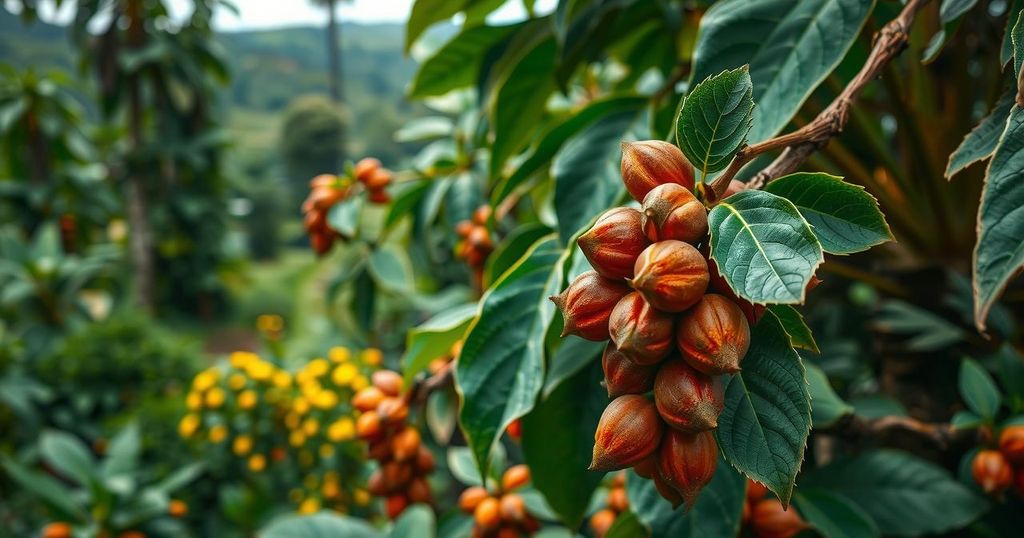This article highlights the importance of agroforestry systems in cocoa farming in West Africa, focusing on research that identifies the role of leaf phenology in enhancing climate resilience. The study categorizes shade trees into functional groups based on their seasonal leaf cycles, providing guidelines for selecting trees that support sustainable cocoa production amid climate challenges. The findings suggest a practical approach to improve cocoa yields and environmental stability.
Agroforestry systems that integrate trees and shrubs into cocoa farming are essential for sustainable cocoa production in West Africa, which accounts for 70 percent of global cocoa supply. Given the challenges posed by climate change, particularly droughts, it is increasingly important to adapt existing farming practices. Researchers from the University of Göttingen have identified the significance of leaf phenology—the seasonal changes in leaf cycles—in shade trees as a means of enhancing climate resilience in cocoa agroforestry systems. Their study revealed that the timing of leaf cycles in shade trees greatly influences both cocoa productivity and the overall resilience of these agroforestry systems to environmental changes. These findings were published in Agriculture, Ecosystems & Environment.
The study involved an extensive two-year field investigation in the northern cocoa belt of Ghana, conducted by a collaborative team from the University of Göttingen, Munich, and Tübingen in Germany, as well as local institutions. Researchers monitored the seasonal changes of various shade tree species, including canopy heights and their capacity to intercept light during wet and dry seasons. The impact of these trees on microclimatic stability, soil moisture, and cocoa yields was assessed comprehensively.
The research categorized shade trees into seven functional groups, each defined by their distinctive leaf phenological cycles and corresponding effects on cocoa yield and environmental stability. Notably, shade trees that completely shed their leaves during the dry season demonstrated significant benefits in preserving soil moisture, which is crucial during drought periods for cocoa productivity. Conversely, trees that retained their leaves for shorter durations exhibited higher soil water demand, potentially detrimental in regions experiencing prolonged dry seasons. Evergreen trees proved advantageous in moderate climates but elevated risks of fungal diseases in wetter conditions.
By establishing functional groupings based on leaf phenology, the research provides practical guidelines for selecting appropriate shade trees that bolster climate-resilient cocoa production. “By using functional groupings based on leaf phenology, rather than focusing on the huge number of individual species, we offer practical guidelines for selecting shade trees that support climate resilient cocoa production,” stated Dr. Munir Hoffmann from Göttingen University’s Faculty of Agriculture.
Lead author Dr. Issaka Abdulai emphasized the importance of leaf phenology in selecting shade trees to enhance cocoa resilience to climate change, asserting, “This study sheds light on the importance of leaf phenology as a guiding trait for selecting shade trees that will enhance cocoa resilience to climate change.” Professor Reimund Rötter further noted, “We have shown that, if chosen judiciously, shade trees can be allies in sustaining cocoa productivity and enhancing environmental stability.” Funding for this significant research effort was provided by the German Research Foundation.
The article discusses the critical role of agroforestry systems in enhancing the sustainability of cocoa farming in West Africa, particularly against the backdrop of climate change. With climate-induced challenges such as drought increasingly impacting agricultural productivity, innovative strategies are necessary to adapt cocoa farming practices. The research conducted by the University of Göttingen provides insight into the practical implications of leaf phenology in improving climate resilience and suggests a strategic approach to selecting shade trees in cocoa agroforestry systems, aiming to bolster both productivity and environmental stability.
In conclusion, the research conducted by the University of Göttingen sheds light on the significance of leaf phenology in selecting shade trees for cocoa agroforestry systems. The findings underscore the need for adaptive farming strategies in response to climate change, highlighting that appropriate shade tree selection can enhance cocoa productivity and environmental resilience. This collaborative research effort presents actionable recommendations for farmers aiming to implement sustainable cocoa farming practices in a changing climate.
Original Source: www.eurekalert.org






